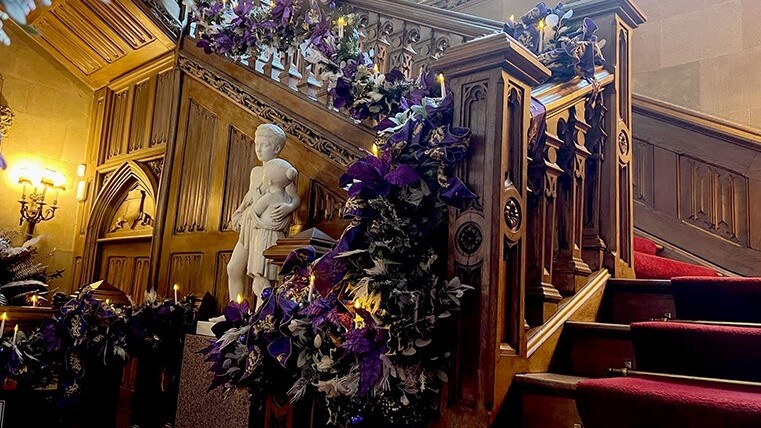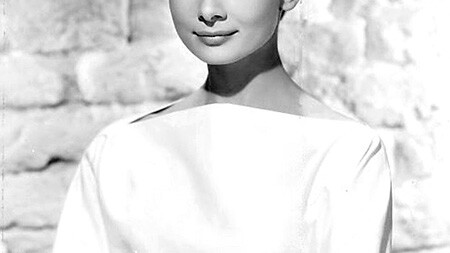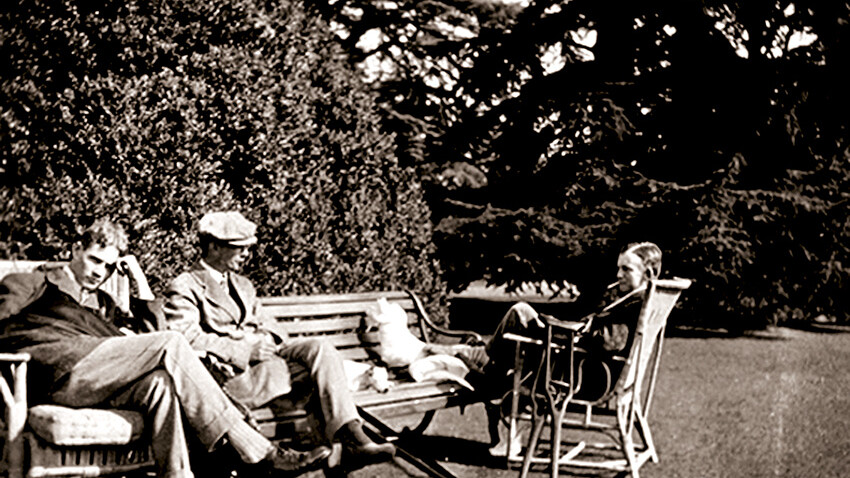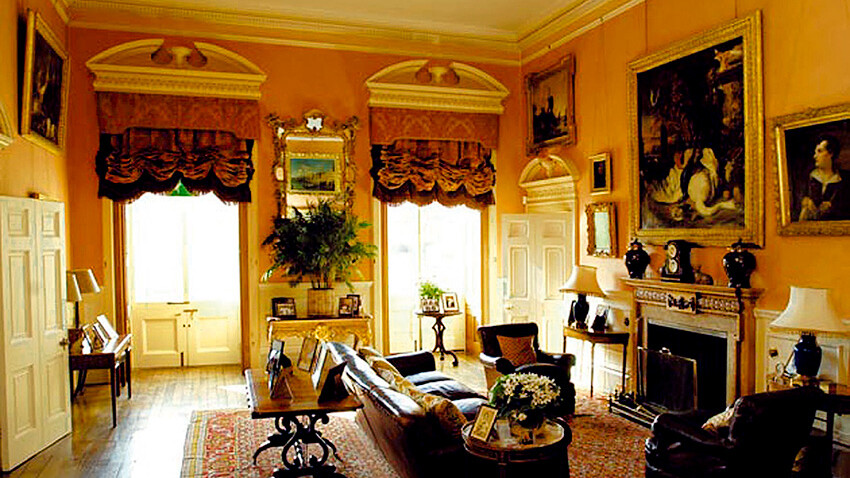Form

Form
 Two children nestle on the landing of the main oak staircase, captured forever in translucent marble. Despite the fact that the little figures are carved from something so incredibly hard and heavy, the statue seems to reflect the light, inviting the observer almost to hold one child’s hand, to admire the perfect realism of their little toes and feet.
Two children nestle on the landing of the main oak staircase, captured forever in translucent marble. Despite the fact that the little figures are carved from something so incredibly hard and heavy, the statue seems to reflect the light, inviting the observer almost to hold one child’s hand, to admire the perfect realism of their little toes and feet. The sculptor carved them snuggled together as loving siblings, the pose reminding us of how loved they once were, cuddled and kissed by their mother. How they must have chattered and gone on adventures together but are now locked in an eternal silent pose.
The Romans called marble "luna stone” – stone of the moon - because it has a light that shines out. Like any statue, this particular work of art undoubtedly began as a sketch, the sculptor working out how to define their expressions and proportions. Then it’s down to hammers and point work, pitching tools, rasps and riffles. Sharp chisels make the crystals bounce back the light and a pumice stone removes any marks.
The sculptor carved them snuggled together as loving siblings, the pose reminding us of how loved they once were, cuddled and kissed by their mother. How they must have chattered and gone on adventures together but are now locked in an eternal silent pose.
The Romans called marble "luna stone” – stone of the moon - because it has a light that shines out. Like any statue, this particular work of art undoubtedly began as a sketch, the sculptor working out how to define their expressions and proportions. Then it’s down to hammers and point work, pitching tools, rasps and riffles. Sharp chisels make the crystals bounce back the light and a pumice stone removes any marks.
 Since ancient times Carrara marble has been particularly treasured. It can take a high gloss polish and holds fine detail. The Carrara quarries have produced more marble than any other place on earth. They have both created local wealth and been a cause of jealousy and anarchy but by the late 20th century Carrara's highest-grade marble had run out.
Since ancient times Carrara marble has been particularly treasured. It can take a high gloss polish and holds fine detail. The Carrara quarries have produced more marble than any other place on earth. They have both created local wealth and been a cause of jealousy and anarchy but by the late 20th century Carrara's highest-grade marble had run out. Marble Arch, for example, a triumphal arch in central London, was created and carved in white Carrara marble two hundred years ago by a team of craftsmen. It has eight huge Corinthian columns each of which were cut from a single slab and was once situated nearer to Buckingham Palace before being removed to a corner of Hyde Park.
Marble Arch, for example, a triumphal arch in central London, was created and carved in white Carrara marble two hundred years ago by a team of craftsmen. It has eight huge Corinthian columns each of which were cut from a single slab and was once situated nearer to Buckingham Palace before being removed to a corner of Hyde Park.
 In contrast, Highclere’s two children were carved by a single master, an Italian called Pietro Tenerani (1789 -1869) born in Terano near Carrara who was commissioned by the Carnarvon family during a tour of Europe.
Tenerani was taught firstly by his maternal uncle, the sculptor Pietro Marchetti, before obtaining a stipend to study in Rome. There he worked primarily in the studio of Bertel Thorvaldsen, a Danish sculptor of international renown who, along with Antonio Canova, inspired many young sculptors to flock to Rome. The pretty rococo style of the 18th century had given way to the strength and clarity of neoclassicism which referenced Greek and Roman art and highlighted harmony of form and simplicity.
In contrast, Highclere’s two children were carved by a single master, an Italian called Pietro Tenerani (1789 -1869) born in Terano near Carrara who was commissioned by the Carnarvon family during a tour of Europe.
Tenerani was taught firstly by his maternal uncle, the sculptor Pietro Marchetti, before obtaining a stipend to study in Rome. There he worked primarily in the studio of Bertel Thorvaldsen, a Danish sculptor of international renown who, along with Antonio Canova, inspired many young sculptors to flock to Rome. The pretty rococo style of the 18th century had given way to the strength and clarity of neoclassicism which referenced Greek and Roman art and highlighted harmony of form and simplicity.
 Whilst Tenerani 's most prominent commissions were for the tomb of Pope Pius VIII in Rome and the colossal statue of St Alfonso de Liquori for the Vatican, he also undertook private commissions for visitors to Rome such as the Earl and Countess of Carnarvon.
The statue of their two children was and still is much admired as emotionally real and artistically perfect. The children themselves remained devoted to each other throughout their lives, echoing the closeness depicted in their statue.
That most famous of sculptors Michelangelo famously explained:
“I saw the angel in the marble and carved until I set him free”
One of the hardest decisions however must be when to stop. To know when a piece is finished and nothing more can be achieved. To quote the poet John Keats:
"Beauty is truth, truth beauty,—that is all
Ye know on earth, and all ye need to know."
Whilst Tenerani 's most prominent commissions were for the tomb of Pope Pius VIII in Rome and the colossal statue of St Alfonso de Liquori for the Vatican, he also undertook private commissions for visitors to Rome such as the Earl and Countess of Carnarvon.
The statue of their two children was and still is much admired as emotionally real and artistically perfect. The children themselves remained devoted to each other throughout their lives, echoing the closeness depicted in their statue.
That most famous of sculptors Michelangelo famously explained:
“I saw the angel in the marble and carved until I set him free”
One of the hardest decisions however must be when to stop. To know when a piece is finished and nothing more can be achieved. To quote the poet John Keats:
"Beauty is truth, truth beauty,—that is all
Ye know on earth, and all ye need to know."


- Christmas
- Community
- Dogs & Horses
- Egypt & Tutankhamun
- Entertaining
- Farm
- Filming
- Gardens
- History & Heritage
- Daily Life
- Royalty
- Cooking
- Interiors
- Heroes
- Architecture
- Cars
- Conservation
- Downton Abbey
- Events
- Gardens & Landscape
- Highclere Castle Gin
- History
- Planes
- Restoration
- Stories & Books
- Uncategorized
- Visitors
- Wildlife
71 Comments
Thank you, what a beautiful carving. Very emotive. Do you know which Earl and Countess the children belonged to?
What an endearing form...complete with fingernails... how does one sculpt such love and tenderness.... Thank you for sharing.
Amazing detail in the sculpture!
Lovely the pictures of form did you and lord Carnarvon and lovely to visit highcelere castle and lam fan of Downton Abbey
I'm Italian, from Mantua, and part of my family comes from and lives in Carrara. I love that place and used to spend a lot of time in the marble caves, when I was younger.
I'm happy to know that part of our wonderful marble is there, in your beautiful and historical place, and so much respected and looked for with care.
Thank you for sharing all these things and in a lovely and passionate way: I read this newsletter every monday and it makes me able to travel with my soul.
Angelica
Marble sculpture has always been a marvel and mystery to me. The talent of it is a wonder.
Thank you, as I have often wondered about the story of this magnificent statue.
Exquisite!
What a lovely story. What were the names of the children please?
Thank you!
Thank you, as always just beautiful.
fondly Jenny
Thank you Angelica. Carrara is a magical place.
What a lovely statue! Such detail is amazing to me.
So beautiful!
Impressive Sculpture Art History and children carved marble statue!
Thank you for sharing.
Speaking of marble....and seeing the lovely sculpture of the two children at the Highclere stairway, united in that eternal silent pose, hoping one day to see the Parthenon sculptures also united in a beautiful eternal silence once again, anything under the sun is possible? Marble is so lovely, thank you for the "luna stone" reference, so true, so true!
When watching Downton Abbey, I am always moved by the statue of the two children you wrote about today. My husband and I visited Highclere this summer on the day of the Magic of the Movies event. We toured the rooms of the castle open to us. All were spectacular and we were grateful to have the opportunity. The one thing I most looked forward to seeing and admired was this statue. Thank you for sharing the story of the sculptor and of the children.
Fascinating, a true gem of Tenerani’s sculpture, so loved by your family throughout the years. Thank you for showing this exquisite sculpture of of the children.
These are the 4th Earl's children.
I can't wait to hear you speak and perhaps meet you in March in Vero Beach, Florida, where I live.I'm sure you have a full schedule, but I would like to invite you to lunch at my Club, John's Island Club. I would be honored if you would join me.
Than you once again Lady Carnarvon for a most interesting blog . Stunning pictures and I will definitely be standing next to the sculpture of the children tomorrow when I visit , I’m so looking forward to seeing your beautiful home again .
Beautiful statue and a very interesting article. hank you
Thank you for sharing the story of the marble and the sculpture of the children. While watching Downton Abbey, I always wondered about that sculpture and if the children were indeed members of the family. So very beautiful!
Lady Carnarvon,
The picture of the statue of the children was my favorite take-away from our visit to Highclere in 2013. I thought then to take a picture as it was so beautiful to me. I’m glad you get to see it up close anytime you wish.
Martha G.
Lady Carnarvon,
This sweet carving touched my heart when we visited Highclere. Thank you for the memory and for the story behind these two ancestors of Geordie. I expect they look at the Christmas tree and its bright lights of childhood!
May your holidays hold the wonders of childhood!
Martha G
Beautiful
Dear Lady Carnarvon,
Whaat a beautiful statue from so long ago. Amazing details that cannot be matched by todays standards. Thank you for the information surrounding the sculpture as well as the marble. Such wonderful stories that take me away from every day life.
Sincerely,
Debbie
So this little boy became the man who funded the discovery of King Tut’s tomb???
Yes indeed
Thank you!
Another illuminating blog on the treasures of Highclere. After our visit earlier this year, these insights into the finer details remind us to make sure we visit again next year.
That's so kind Patricia, I will look at the schedule for the trip and revert back to you if that's ok. Thank you again.
I'm disappointed I didn't pay more attention to this statue when I came down the stairs during the tour. Somehow we must have gotten distracted looking at something else. Great story. Thank you!
All of your posts are so very interesting and informative! When you said that Tenerani did commissions my immediate thought was that this must be family ancestors, but the style of clothing threw me. Thank you for telling us who the children were!
Thank you.
Lady Carnarvon.........If the sculpture is of the 4th Earl's children, then the boy would be the future 5th Earl who funded king Tut's dig. It's wonderful how the family through the ages is woven throughout the castle. The sculpture is beautiful...so detailed.
They are beautiful and so perfect. We came to Highclere a couple of years ago and I was so taken with the sculptures they really felt like you could speak to them xxxx
THANK YOU FOR SHARING THESE VERY INTERESTING STORIES .
Happy Holidays and May 2024 bring you continued love & joy for many more years to come. Thank you again. -Josie
Dear Lady Carnarvon,
Thank you for sharing the children with us. It is amazingly beautiful. We have a masterpiece here in St. John's Newfoundland. It is the Veiled Virgin by Giovanni Strazzo. The awesome sculpture is carved from Carrara marble. I am always left in awe when I see a marble sculpture. Michelangelo did describe it beautifully when he said it is set free. Again thank you. Take care.
Susan
Beautiful ,thank you ,
Lady Carnarvon: You have such a wonderful way with words, no wonder you've written many books, which I believe I have most of them. I've ordered your latest "Seasons at Highclere" from my local book store and simply can't wait to get it. I know I will enjoy it so very much, just as I've enjoyed your others. This statue is absolutely beautiful and so life like. Thank you so much for sharing. Donna Grubbs
Wow, I'm a Historian to a historic Washington Home in West Virghinia. This is one of the nicest stories I have read. So glad you dug this one out of your archives. Especially at this holiday time.
Lovely the pictures of form happy Christmas to you and lord Carnarvon l lovely Christmas it is my birthday on Boxing Day and lovely to visit highcelere castle and l am fan of Downton Abbey
Delicate and loving sculpture. Like a brother protecting his little sister. Full of emotions.
Thank you for sharing with us.
My husband and I with our children lived for 2 years in Italy in the early 70’s. We felt very privileged to be surrounded by majestic art. Then on to England for 10 years, which inspired me to become a fine art dealer form 25 years. How fortunate for our family to
be in two countries that have produced so many talented sculptors and painters. Thank you for sharing your thoughts and the treasures of Highclare.
Dear Lady Carnarvon,
Best of the Season to you! I love your Monday blogs but this exquisite sculpture is so tactile in its details that I expect the children to draw breath and scamper down the staircase. Thank you for sharing its story.
All the best, Victoria Kendall Blinkhorn
Thank you for another lovely Monday read about your home. Your weekly blogs add an extra richness to the special memories my sister and I made on our 2 visits to Highclere.
Did the yellow rose beside the Green Man pick up, or did you have to replace it? The gardens were full of colour in July and we enjoyed our brief chat with you under the majestic cedars. Thank you for taking the time to do that. You have such a busy life.
Have a wonderful family Christmas
Beautiful!
Dear Lady Carnavon,
You have a particular talent for including both moving and instructive details in your stories. I loved your description of the 'luna stone' marble (I live in mostly hot Rio de Janeiro, and my living room floor consists of large cool squares of Carrara marble), the carving process, as well as your thoughts about the trustful children. The pictures and your words will stay with me. Thank you for sharing.
P.S. I know you're fond of dogs, as am I. I have two rather large German shepherds, who adore cooling off on that luminous white floor.
Beautiful words as always Lady Carnarvon,so lovely. I hope your gorgeous dogs
are well. I just love your photos of them all.
Dear Lady Carnarvon,
Could you please tell me the names of the 4th Earls children that are depicted in this amazing statue??
Thank you,
Sincerely, Mary KinneDescy
My husband and I recently returned from a tour of Italy. We passed Carrera on the way to Cinque Terre. You confirmed what our tour director mentioned that the marble has been over-mined. There were many big blocks of marble along the rails waiting for shipment. Highclere is fortunate to have a part of the early Carrera marble. The statue of the children is a treasure for generations to come.
I love your quote from Michelangelo because that is how he sculpted, by envisioning what he wanted to sculpt - he was an amazing genius!
My dearest Lady Fiona,
Lovely day for you, milady,it's a rainy day in my city in Rio Claro. I love Marble House in Newport in USA ,but the pink
marble columns of The Grand Trianon in Versailles , FRANCE are superb too. The White marble mine in Carrara is stunning.
Italian Master Sculptures. Beautiful Timeless Art
P.S.Milady, would you have any information about the origin of this beautiful blue marble on the columns of the castle entrance hall ??? Thank you very much.
Vila Alemã
Rio Claro- S.P.
Brazil
I am going to have to replant the rose but better done in the depths of winter
Henry, who became the fourth Earl and his sister Eveline, who married Lord Portsmouth.
He was indeed.
Thank you so much
They are french marble
thank you - I hope you enjoyed your visit!
Henry and Eveline
Good Afternoon - thank you I am honoured to be invited by the education charity in Vero Beach and its find raising efforts at Vero so I
think my time will be taken up with the sponsors and attendees!
Thank you
Thank you for the art history lesson, we have seen that statue there in so many episodes of programs filmed on the premises and now we know.
Thank you for the sign book of your and happy Christmas to you and lord Carnarvon and your staff l enjoyed my visit today to highcelere castle with my sister Catherine and love Christmas and it my birthday on Boxing Day and your house is lovely
Thank you!
Dear Lady Carnarvon:
Thank you for this Monday's blog and sharing such an interesting story about this exquisite marble statute.
Perpetua Crawford
What a beautiful story! Thank you for sharing.
Spent a wonderful day at Highclere recently and was amazed at the beautiful decorations - the theme this year was purple and it looked wonderful. In the marquee outside we were treated to some wonderful Christmas songs from a choir of Ukrainian ladies, some in English and some in Ukraine. Thank you so much for brining Christmas alive.
Lady Carnarvon,
Thank you for sharing this beautiful story of this remarkable sculpture and these lovely siblings. I imagine their life story must have been interesting.




Lovely, thank you for sharing,